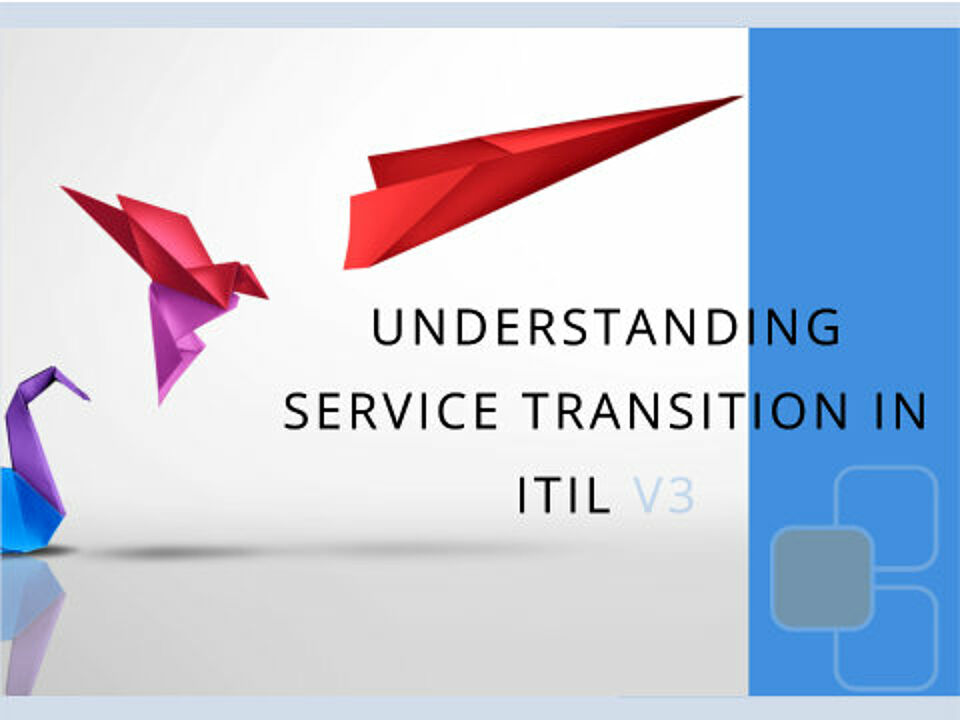
Meaning of Service Transition according to ITIL v3
Understanding the term Service Transition according to ITIL is essential for any company that wants to ensure a smooth and efficient IT process. In this blog post, we explain what exactly is behind this term and why it is extremely important. Don't worry, this is not a meeting of IT experts and you don't need a computer science master's degree to follow along. Today we are taking a journey together into the world of service transition, presented in a simple and entertaining way. Make yourself comfortable and join us on this exciting journey through processes, change and the drive for improvement that is the foundation of Service Transition.
You enter the shop Service Transition according to ITIL® and wonder what it is. Don't worry, we'll explain it to you.
In the world of information technology, it's a stage in the service management process. According to ITIL 3 - which is the library that forms the rulebook for all of this - Service Transition refers to the critical moment when an IT service is moved from the development or change phase to the production environment. Too complicated? Don't worry. It's just the process by which an IT department ensures that it delivers new and/or changed services to the end user effectively and efficiently.
But why is this important? In a world that is changing rapidly and in a market that is constantly innovating and responding to consumer needs, changes in a company's technical services are inevitable. Imagine driving a car from the 80s on a racetrack full of modern Formula 1 cars. Not only do you finish last, but you also run the risk of going under the wheels. It's the same in the business world. Without effective processes, companies run the risk of being left behind by the competition.
The ITIL rules define service transition as a specific phase in the service lifecycle that ensures that changes (whether large or small) are controlled and implemented effectively. According to ITIL V3, this includes change management, service asset and configuration management with the configuration management database (CMDB), and release- and deployment management. Together, these tools ensure that every step, every change is monitored, analysed and effectively implemented to ensure seamless service operations.
Service transition is at the heart of any successful IT organisation and the key to continuously improving IT services that meet market needs. Thanks to ITIL, it is a controlled, regulated and managed leap into warm, refreshing new waters.

Service transition process - the journey of a service from idea to deployment
- Transition Planning and Support: Here we go! This phase is all about a detailed roadmap for our service. Here we plan and coordinate the resources and capacities needed for the implementation. We also make sure that everyone involved - from developers to management - is on the same page and working together harmoniously.
- Design and development of new or changed services: After planning the way forward, the creative phase begins. This is where new services are developed or existing ones are improved. The service design of the service must meet all business requirements and at the same time be easily integrated into existing service operations.
- Service and process validation and process testing: We are now in the testing phase. Before we introduce the new and/or changed service, we need to make sure that it works! To do this, we carry out various tests to make sure that all processes are working optimally and that there are no surprises waiting for us.
- Knowledge transfer and management: Knowledge is power - this also applies here. In this phase we make sure that all the necessary information about the new and/or changed service is passed on to the relevant people. This is not only about making sure that the staff who are implementing the service know what they are doing. It is also important that users understand what the service can do and how they can make the best use of it.
- Evaluation and transfer of services into regular operation: Finally, the big moment we have all been working towards arrives - the launch! But before we put the service into operation, we take the time for a final check. Does the service fit our business strategy? Does it meet all the requirements? Is it efficient and effective? Is the whole team ready for the changeover? If all criteria are met, then it's - Voilà! Our service is ready to go live.
According to ITIL, it is a crucial phase that every company must master. With planning, creativity, testing, knowledge transfer and a final evaluation, we can efficiently move from the old to the new service - and the better we master this phase, the more successful we will be!

Roles and responsibilities - The key players
The Service Transition orchestra consists of several musicians who must master their respective instruments to create a harmonious whole. Who are these musicians? Let's take a look at the main players.
- The Transition Manager: The conductor of our orchestra. The transition manager plans and coordinates all activities related to the transition. He monitors the progress of each phase, manages resources and is the main point of contact for all stakeholders. He is also responsible for identifying, managing and coordinating the technical and organisational aspects.
- Change Manager: The person who ensures that all changes run smoothly. The Change Manager assesses, reviews and approves changes to IT services and ensures that these changes have minimal impact on services and users.
- Release and Deployment Manager: The Release and Deployment Manager is responsible for planning and controlling, designing, creating, testing and deploying releases. He or she ensures that the whole team works and that all changes can be introduced effectively and efficiently.
- Service Validation and Test Manager: In our world, the Service Validation and Test Manager corresponds to the Quality Assurance Manager. He or she is responsible for organising and conducting tests to ensure that all new or changed services meet the requirements of the users.
- Change Evaluation Manager: Last but not least, the Change Evaluation Manager is responsible for analysing and documenting the benefits, costs, risks and drawbacks of any major change. He or she ensures that all risks and benefits are understood, documented and communicated with all stakeholders.
Each of these stakeholders plays an important role in the implementation and together they ensure that the changes to IT services are rolled out as smoothly as possible and provide the maximum benefit to users. Because, as the well-known saying goes - teamwork makes for success!

Tools and techniques - How good IT tools facilitate implementation
Now that you know the different roles and processes of service transition, let's take a look at the tools and techniques that help the transition orchestra play its melody smoothly and harmoniously.
To even get started, we need powerful IT tools to support our work. There are data and analysis tools, change management software and a number of specific ITIL-based service transition tools. Which of these are right for you and which are not will depend on a number of factors such as our specific business model, our industry, our budget and, of course, our IT infrastructure.
However, if you are looking for best practices in tool selection, there are some general guidelines to follow:
- Evaluate features and functions: Check that the tool offers all the functions and features you need for your specific processes. Also make sure that the tool is compatible with your existing systems.
- Adaptability: It is not enough that a tool works well today. It should also be flexible enough to adapt to future changes.
- Usability: A tool is only as good as the person using it. Choose tools that are user-friendly and intuitive to use.
- Support: A good tool should always be accompanied by good support. Check if the provider offers support to help you get the most out of your tool.
After all, no tool is more valuable than a well-trained, communicative and committed IT team. Why? Because ultimately all tools and techniques are operated and managed by people. And the better your team works together, the more successful your implementation will be.
Always remember - change is not always easy, but with the right preparation, the best people and the right tools, it can open up unimagined new possibilities.

Change Management in Transition Planning - The Key to Implementation
Are you in the flow of constant change? In the service transition according to ITIL v3 definitely, because that is what change management is all about!
But what does it actually mean? Change management is the process of controlling and managing changes to IT services to minimise any potential negative impact on service operations. In simpler terms, it helps to make changes as easy and smooth as possible.
You can think of change management as a kind of director running a stage production - coordinating all the changes, making sure everything goes to plan, and intervening when things don't go as they should.
A well-integrated change management function is critical to the successful transition of new or changed services into the production environment. It ensures that all changes are carefully recorded, reviewed, approved and implemented. At the same time, effective change management ensures that all existing services remain stable during the transition.
And how does it fit into the process? It essentially runs through all phases and activities of the implementation. From planning and organising changes, to evaluating and approving change proposals, to monitoring and documenting the entire change process. In this way, change management contributes to a smooth and efficient transition.
And this is exactly where the magic of ITIL lies: it enables a structured and systematic approach to change that minimises risks while maximising efficiency and service quality. This transforms change from a challenge to a successful opportunity for growth and improvement.
Whether you are introducing a completely new service or improving an existing one, ITIL change management provides you with the tools to make change a success. Change may be constant, but with change management you can be sure that this constant change is always in the right direction.

Success factors for a successful service transition - anchors of implementation
Like cooking, the ITIL Service Transition needs certain key ingredients to be successful. But what are they and how are they used correctly? Here are some of the key ingredients:
- Committed leadership: just as Guido leads the way for a tour group, leadership pulls the company in the right direction. This commitment is crucial to the success of the implementation. A good example of this is a northern German district administration that was rewarded with a significant improvement in efficiency and customer satisfaction after leaders actively engaged in the transition process.
- Clear communication: Open and continuous communication between all stakeholders is another key factor. For example, the leading manufacturing, trading and service company that distributes high-quality sun protection systems in Switzerland and Europe was able to avoid major setbacks by ensuring that everyone was on the same page through vertical and horizontal communication - even across departmental boundaries.
- Effective support: Without sufficient staff support, implementation can easily stall. However, a large DIY and garden centre operator managed to significantly increase the efficiency of its IT services by investing in training programmes for its staff.
- Continuous improvement: No system is perfect and it is essential to constantly look for ways to improve services. For example, a software vendor for an accounting and controlling solution. has always paid attention to feedback from customers and employees and used this to continuously improve its services.
- Using the right tools: Finally, the success of the changeover can depend heavily on the tools used. For example, an internationally positioned manufacturer of high-quality drive technology, braking and cooling systems for the mechanical and plant engineering industry was able to significantly accelerate its transition process after investing in a feature-rich IT service management tool.
These key components are signposts on the way to a successful implementation. They help smooth the process and ensure that the desired outcome is achieved. But once again, it is evident that the real key to success lies in the continuous effort to be better every day than the day before. With this attitude, you can be sure that your project will have a positive and lasting impact on your business.

Challenges and how to overcome them
As with any important process, service transition can present some challenges. But don't worry, there are solutions for difficulties in the process. Here are some examples:
- Lack of collaboration: when different departments and teams need to work together during phases, it can be difficult if not everyone is on the same page or has the same goal. Supporting open and honest communication is crucial to ensure everyone understands the goals and processes.
- Resistance to change: It is to be expected that resistance will be formed. An approach: Therefore, it is advisable to explain the benefits of the planned changes and create a safe space for concerns and suggestions.
- Lack of training: staff need to be adequately trained to effectively implement and operate new or changed services. Invest in comprehensive training and ensure your staff have the skills and knowledge they need.
- Lack of or inadequate processes: Without clear and well-defined processes, the transition can quickly become chaotic and inefficient. Recommended solutions: Create clear processes and follow established ITIL practices.
- Lack of resources: Implementation requires time, money and staff. Plan ahead and make sure you have the necessary resources.
Always remember: challenges are not there to discourage us, but to help us grow and improve. With the right mindset and strategies, you can overcome them and make your transition successful.
Summary and conclusion ITIL Service Transition
In summary, ITIL Service Transition could be said to be at the heart of all changes in IT services. It is the process that bridges the gap between service development and service operations by ensuring that all changes are effectively and efficiently transitioned into ongoing operations.
Implementation requires a range of roles and responsibilities, from transition manager to change evaluation manager, and makes use of a wide variety of tools and techniques. Well-implemented change management is a crucial aspect of this, as is effective communication and continuous improvement.
But even though we are mainly talking about IT services here, it should not be forgotten that the principles and methods of service transition are equally applicable to non-IT services. Whether in finance, human resources or customer service, wherever services need to be changed or improved, ITIL Service Transition can provide valuable guidance.
The drive for continuous improvement that forms the basis of Service Transition will become increasingly important as organisations look to meet the changing needs of consumers and technological developments. It is therefore important that you use this momentum, led by Service Transition, to your advantage. This way, you can not only meet the challenges of constant change, but also turn them into opportunities for growth and improvement for your business.
